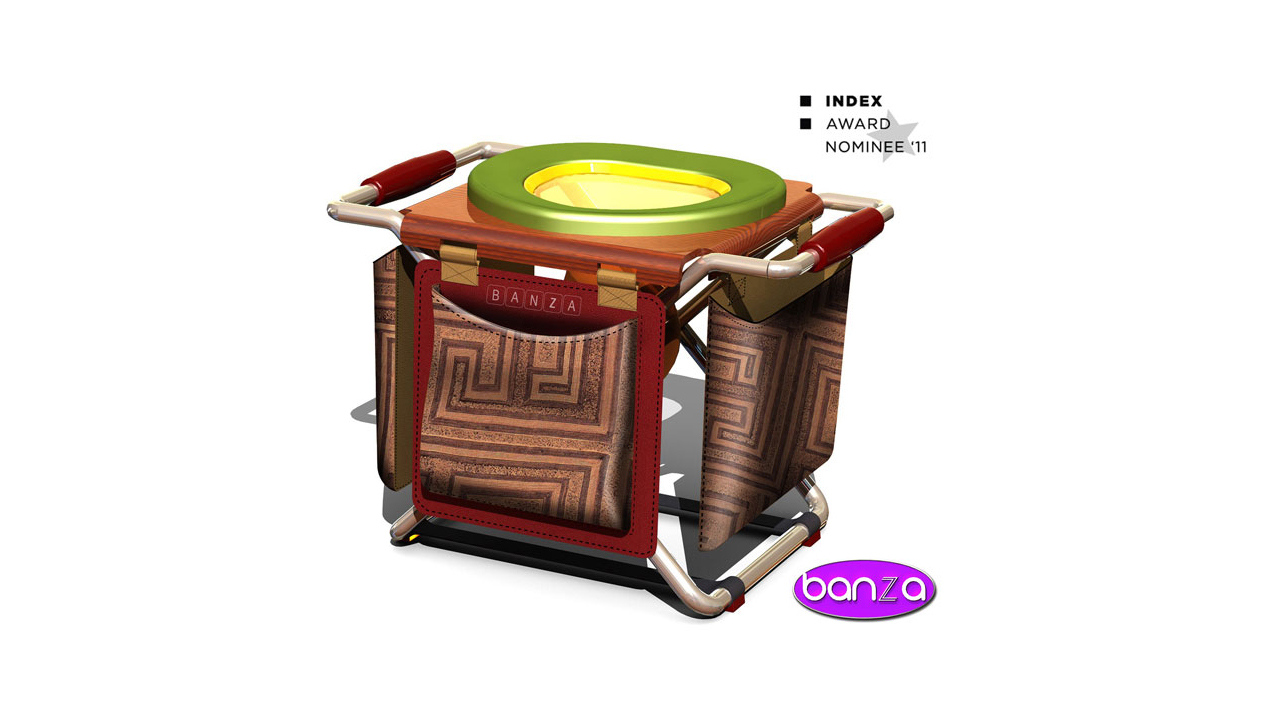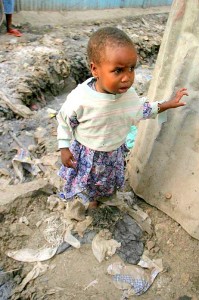Patrick Kiruki (Product ’05) is a product designer and social entrepreneur, focused on using design and innovation to find solutions for economic development in health, sanitation, and environmental concerns that the bottom half of the economic pyramid face on a daily basis.. His areas of expertise include technology development, the digital media/3D process, new product research and development, ethnographic research, consumer design language, social enterprise, and sustainability, He is the principal lead designer at Alru Design Consultancy, dedicated to “solutions and social innovations at the ‘base of the pyramid’”. Patrick currently lives in both LA and Nairobi.
Designing a System Around Sanitation in Kenya
In 2011, my design for a sanitation solution was nominated for an INDEX award. I did not win the award, but the design raised so much interest in East Africa, that the need to implement the solution was imperative. In 2011 I went ahead and established Banza Limited a for-profit organization in Kenya, with a mission to use design as a tool to empower people’s lives,in particular to benefit those most in need with better solutions and product options. Good design should not be reserved for those with the greatest purchasing power, but rather we believe in using design and innovation to find solutions to the economic, health, sanitation, and environmental concerns that the bottom half of the economic pyramid face every day. We are thus committed to developing and producing products at the lowest price point possible, in order to provide the greatest accessibility to those who can benefit from such design innovation.It sounds odd to think that a sustainable business model could come from that—why not just give the products for free since they cannot afford based on income? Or is it even worth it?. Well, it is proven that Africa does not need aid, but rather appropriate investment in its people. There is a massive grassroots movement in Kenya that is engaging the bottom half of the economic pyramid through banking, telecommunications and information, and with that, a whole new economy is emerging, new models of business have been developed around those economies, and it is growing in leaps and bounds.
About Banza Ltd:
Banza Ltd. is a social enterprise venture in Kenya addressing sanitation and health concerns in East Africa. At Banza we aim to address the full spectrum of human waste management and the health and environmental problems that result from poor sanitation conditions in informal living settlements. We believe everyone has a right to a dignified, safe and hygienic means of disposing human waste. Our goal is to create a cleaner, healthier environment and economic opportunity through a collective human waste management system, beginning with the Banza Toilet and the opportunity for individuals to take ownership of their sanitation circumstances and contribute to a healthier living environment, and by so doing we are meeting the eight United Nations Millennium Development Goals which are as follows:
- End poverty and hunger
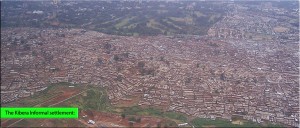
- Universal education
- Gender equality
- Child health
- Maternal health
- Combat disease
- Environmental sustainability
- Global partnership
Background – The Sanitation Crisis in Nairobi’s Slums:
Approximately 2.6 billion people around the world use unsafe toilets or have no toilet at all. In Kenya, and the African continent as a whole, access to sanitation services is a critical problem due to limited water resources and lack of infrastructure. In Kenya, water supply coverage is 59%, and only 31% of the total population of 38 million had access “improved” sanitation services as of 2008 according to the World Bank. (Improved sanitation services defined as facilities that ensure the hygienic separation of human waste from human contact. Such facilities include flush or pour-flush latrines to piped sewer systems, septic tanks, or pit latrines; ventilated improved pit (VIP) latrines; pit latrines with a slab; or composting toilets.) As a result, the majority of urban and rural Kenyans use one or more of the following means of human waste disposal: “unimproved” facilities such as pit latrines lacking a slab or platform, hanging latrines, and bucket latrines; shared public toilets; or open defecation (aka the “flying toilet”). Poor sanitation conditions contribute directly to the country’s high instances of water-borne illnesses causing disease and death. Kenya’s overall health and economic statistics go hand in hand with inadequate sanitation: • Each year 25,000 children under five die from diarrhea • Infant mortality is 85/1000 • Life expectancy in the country is 55 years • 46% of the population lives below the poverty line The most severe sanitation problem is found in Kenya’s informal settlements, or slums, concentrated in the capital city of Nairobi. Nairobi’s population is 3 million, and it is estimated that approximately half of the population lives in slums throughout the city, which cover only 5% of the city’s area. The slums are not recognized by the government as legal settlements, and are thus excluded from receiving any municipal services such as water, sewage, lighting, security, etc. International organizations and local NGOs are left to fill in the gaps, but it is evident that a long-term broad solution is needed in regards to sanitation services in informal settlements. The lack of proper sewage and drainage systems in Nairobi’s informal settlements forces residents to use unhygienic pit latrines, or to dispose of their waste using the “flying toilet” method, flinging their waste in a plastic bag into alleyways and the shallow trenches that run through the slum. Pit latrines are extremely unsanitary, and in essence become toxic waste dumps for the future, contaminating ground and water sources. As a result, residents have high incidences of diseases such as typhoid, cholera, tuberculosis and dysentery, which are transmitted through contact with fecal matter and contaminated water supply. As a result of the sanitation crisis in Kenya and in the African continent as a whole, more children die each year from diarrhea than from AIDS and malaria combined, yet problems like access to clean water will never be truly resolved if we do not address sanitation first. To address this sanitation crisis, the Banza Sanitation solution aims to create a cleaner, healthier environment and economic opportunity through a collective human waste management system for populations living in informal settlements, beginning in Nairobi’s Kibera slum.
Our Solution:
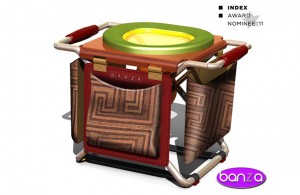 The Banza Sanitation Project aims to address the full spectrum of human waste management as well as the health and environmental problems that result from poor sanitation conditions in informal living settlements. We place our initial focus on human waste collection, starting from the home with the Banza Toilet—a foldable, multi-functional unit designed for in-home use in places where sewer systems or proper sanitation methods do not exist. • Foldable and portable: it can be folded away out of sight, and is easily transported • Durable and stable to support frequent use • Ergonomic design to suit a wide user demographic, specifically serving the needs of the elderly and disabled • Hygienic, easy-to-use compostable disposal bags • Toilet lid that seals to prevent odors • Aesthetic value: in understanding local taste, and trends, as a part of the furniture of the home, the toilet is designed to complement the existing living spaces of informal settlement dwellings • Human dignity: promotes a more comfortable, dignified way to dispose human waste than using a dirty pit latrine, squatting over a plastic bag that will become a “flying toilet,” or simply open defecation. • Health: each use of the Banza toilet signifies one less “flying toilet” contaminating the environment. Widespread use could result in significant improvement in the slum’s health circumstances.
The Banza Sanitation Project aims to address the full spectrum of human waste management as well as the health and environmental problems that result from poor sanitation conditions in informal living settlements. We place our initial focus on human waste collection, starting from the home with the Banza Toilet—a foldable, multi-functional unit designed for in-home use in places where sewer systems or proper sanitation methods do not exist. • Foldable and portable: it can be folded away out of sight, and is easily transported • Durable and stable to support frequent use • Ergonomic design to suit a wide user demographic, specifically serving the needs of the elderly and disabled • Hygienic, easy-to-use compostable disposal bags • Toilet lid that seals to prevent odors • Aesthetic value: in understanding local taste, and trends, as a part of the furniture of the home, the toilet is designed to complement the existing living spaces of informal settlement dwellings • Human dignity: promotes a more comfortable, dignified way to dispose human waste than using a dirty pit latrine, squatting over a plastic bag that will become a “flying toilet,” or simply open defecation. • Health: each use of the Banza toilet signifies one less “flying toilet” contaminating the environment. Widespread use could result in significant improvement in the slum’s health circumstances.
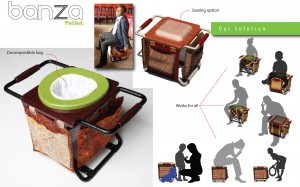 I designed The Banza Toilet specifically for use in informal settlements, whose average occupancy is between 5-8 people per shack. It allows users to hygienically dispose of human waste in the security and privacy of their own homes, on a comfortable Banza toilet that is modeled in scale on a standard sized western toilet. The side handles offering stability during entry and exit, in particular for the elderly, disabled and sick. Its steel-tube frame provides strength and durability, the seat base and toilet seat are made of non-stick, easy-to-clean plastic, providing a comfortable, hygienic seating surface. Materials choices are informed by hygienic considerations, durability, practicality, and cost. The toilet’s scissor-folding mechanism allows it to be folded away out of sight when desired. It can also be used as part of the furniture, making it practical for very crowded living arrangements. When not in use as a toilet it serves as a stool by replacing the toilet seat with a cushioned cover. Fabric bags offer storage for toilet supplies and obscure the disposal bag from view, allowing it to function aesthetically as part of the furniture.
I designed The Banza Toilet specifically for use in informal settlements, whose average occupancy is between 5-8 people per shack. It allows users to hygienically dispose of human waste in the security and privacy of their own homes, on a comfortable Banza toilet that is modeled in scale on a standard sized western toilet. The side handles offering stability during entry and exit, in particular for the elderly, disabled and sick. Its steel-tube frame provides strength and durability, the seat base and toilet seat are made of non-stick, easy-to-clean plastic, providing a comfortable, hygienic seating surface. Materials choices are informed by hygienic considerations, durability, practicality, and cost. The toilet’s scissor-folding mechanism allows it to be folded away out of sight when desired. It can also be used as part of the furniture, making it practical for very crowded living arrangements. When not in use as a toilet it serves as a stool by replacing the toilet seat with a cushioned cover. Fabric bags offer storage for toilet supplies and obscure the disposal bag from view, allowing it to function aesthetically as part of the furniture.
Collection and Disposal:
The Banza system of human waste management involves the following processes of collection and disposal:
- Daily collection of used disposal bags and containers from the homes of our users by our partner organization Community Cleaning Services team, a Kenyan nonprofit that is improving urban sanitation while creating profitable entrepreneurial opportunities for youth from low-income communities.
- Supplying Banza Toilet users with additional disposal bags and collection containers as needed
- Disposal of waste collected from homes in a septic tank systems installed outside the city’s environs
- Partner with organization’s that convert waste matter into biogas and fertilizer
The Banza Toilet is designed to separate solid and liquid wastes for the primary purpose of collecting urea separate from solid waste. Urine contains large quantities of nitrogen, phosphorus and potassium, nutrients that have a high market value and are among the primary macronutrients required by plants, allowing the collected urine to be marketed as fertilizer. Urine will be collected in an attachable container, and solid waste will be disposed of in a compostable bag designed specifically for use in conjunction with the Banza toilet. The Banza toilet will also be designed with the option of excluding the urine collection container and collecting liquid and solid wastes together in the compostable bag, depending on the needs of each user demographic. Solid waste (and liquid wastes if desired) collected in a compostable disposal bag will be gathered and disposed of in an aerated commercial septic tank system. Urine separation is the single most important factor in maintaining an odour free compost toilet, and an integral part of our composting toilets. Urine and stool separator provides a no mess no smell waterless toilet. Both the solid and liquid waste products will be collected from homes by our partners Community Cleaning Service; the collection management team is very crucial component of our project. The toilets, collection procedure and septic tank processing technology will all be engineered together as a tightly orchestrated system to prevent any human contact with the waste and to coordinate the timely collection and disposal of the waste and the delivery of new disposal bags and urine collection containers.
Septic tanks are currently used in Kenya in private homes and in commercial settings. Smaller in scale than public sewage treatment systems, septic tanks are vessels buried underground for the purpose of collecting and treating sewage. When waste is discharged into the septic tank, the solid and liquid wastes separate, with solid wastes forming the bottom sludge layer, and lighter solids rising to the top to form the scum layer. An anaerobic bacterial environment develops that decomposes the solid waste, reducing it significantly in volume and breaks down the harmful pathogens. The middle layer is a relatively clear substance called effluent, which after the separation of materials enters the soil treatment phase by seeping into the drain field or soak pit, where it undergoes a natural treatment process by which a large portion of pathogens are destroyed as the effluent moves through the gravel bed and on to the natural soil, eventually being taken up by plant systems or evaporating. The solid waste or sludge that is not decomposed by the process of anaerobic digestion must eventually be removed from the tank. When properly installed and maintained, septic systems can treat wastewater better than traditional sewage systems. Septic systems are a viable option as part of the Banza toilet solution because they are a much more cost effective method than other sewage treatment facilities, and are better for the environment as well. We are currently preparing to launch a pilot with our partners, Community Cleaning Services.
Crowd Funding Campaign:
We have initiated a crowd funding campaign to establish a pilot project in Nairobi, which we hope will provide us with the best course of action moving forward. Check out our online campaign to fund the Banza pilot project: www.indiegogo.com/banzasanitation. “Like” our campaign on Facebook, leave a comment, donate $1 – every little bit helps! Let’s play our part in creating a global partnership. You can reach me at Kiruki@alrudesign.com or www.alrudesign.com
